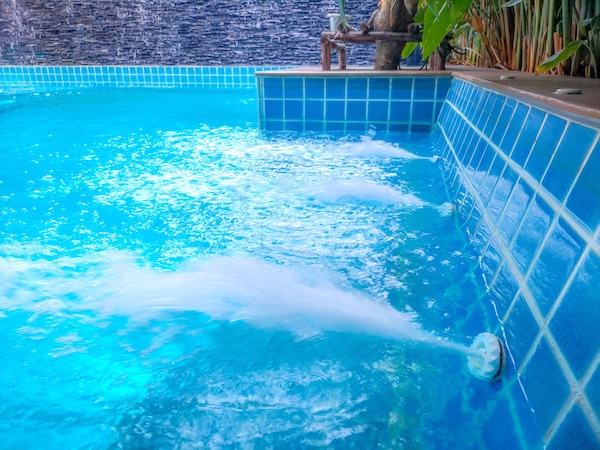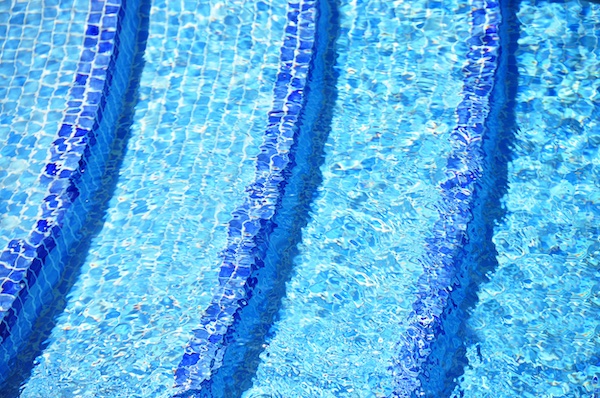– sponsored content –
Pool construction is undergoing a revolution, propelled by cutting-edge technologies and innovative materials that are reshaping traditional methods. From leveraging 3D printing for pool design to incorporating advanced high-efficiency construction products, the time from concept to first swim is shrinking. Yet, client expectations continue to grow, for pool aesthetics, eco-friendly and sustainable design, efficient construction, and easy long-term maintenance. Tiled pools help meet all these demands, with a wide array of design options, color combinations, and eco-conscious materials. Tile also allows for highly efficient construction, durability, and very little maintenance versus other pool substrate options. Today’s advanced setting materials enable the tile pool installation process and pool performance guaranteed to delight owners for the long term.
Crack Isolation and Waterproofing
The first step in preparing the pool for tile is to waterproof and prevent concrete cracks. High-performance TEC® Triple Flex™ Waterproofing Crack Isolation Membrane should be installed directly onto the concrete shell. The unique cementitious waterproofing of Triple Flex allows it to be used under a latex-modified mortar mixed with latex acrylic additive. This combination of advanced materials helps achieve the substrate flatness requirements for the pool. For tiles with all edges under 15 inches long, the requirements are as follows: no more than 1/4” substrate variation in 10’ and no more than 1/8” substrate variation in 2’. For tiles with at least one edge over 15 inches long, the requirements are twice as strict: no more than 1/8” in 10’ and no more than 1/16” in 2’. After the latex-modified mortar bed is complete, a second layer of waterproofing membrane is required. Follow manufacturer recommendations for how many coats and the mil thickness required for efficacy.

Tile Adhesive or Mortar
The tile size and composition help determine the optimal adhesive or mortar to use to install the pool area tile. Ultra-high performance, moisture curing, modified silane adhesive can adhere porcelain pool tile, glass tile, or small ceramic tiles efficiently. New TEC® TotalFlex® XMS Tile Adhesive is a unique ultra-versatile product in a category all its own. Developed for use in chlorinated or saltwater pools, this pre-mixed, ready-to-use adhesive is ideal for interior or exterior pools, water submersion, clear/transparent glass tiles, standard tiles, and even challenging gauged porcelain panels installed on pool room or pool area walls. It exceeds ISO 14448:2016 specifications for reactive adhesives used for the installation of tiles to exterior walls.
This tile adhesive saves installers significant time and effort through robust non-sag/non-slump properties, strong initial grab, extended tile repositioning time and application to just the tile back or the substrate (not both), and accelerated curing enabling grouting after 12 hours. With this game-changing adhesive, tile pools can now be repaired, installed, and refilled in as few as seven days after grouting, while a traditional mortar would require 28 days to reach full cure.


Grout and Sealant
Once the tile is ready for grouting, choose a grout designed for wet or submerged environments. Power Grout® Ultimate Performance Grout easily meets challenging pool and pool area requirements. Designed to fill joints as small as 1/16” and as large as 1/2”, this grout is crack and shrink-resistant, stain-proof, efflorescence-free and ready for traffic in just four hours. It requires no sealing and exceeds the requirements of ANSI A118.7 when mixed according to the product data sheet instructions. Extra strong, the grout stands up to pool chemicals, weather, and high foot traffic.
Finally, address any change of plane or movement joints with sealant: a 100% silicone product is recommended. Silicone stays flexible and weather resistant. All movement joints are specified in the TCNA Handbook section EJ171 and should be treated properly throughout the entire installation. To ensure the pool’s longevity and beauty, make sure owners know that proper maintenance is performed regularly.
A tile swimming pool is a rewarding investment for property owners. Today, thanks to advancements in technology, the time required to design and build a tile pool is significantly shorter than ever before, without a sacrifice in quality. Whether a sprawling commercial pool or a bespoke spa with intricate water features, pools deliver much-needed recreation, fitness, and stress reduction. With the latest advanced product systems, installers can efficiently and effectively complete a quality tile pool in record time, ensuring highly satisfied customers.
Written by John Corley







